Prove: If [latex]a < b[/latex], then [latex]a < {\Large{{a + b} \over 2}} < b[/latex].
Before we start proving the theorem, let’s make sense of it first. What is the theorem trying to tell us in plain English? Let’s break it down into something that we can understand. Again, here’s the theorem.
Suppose [latex]a[/latex] and [latex]b[/latex] are real numbers, if [latex]a < b[/latex] then [latex]a < {\Large{{{a + b} \over 2}}} < b[/latex].
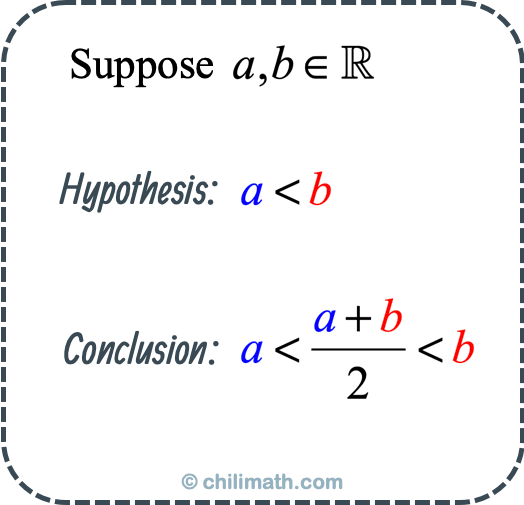
The hypothesis of the theorem is [latex]a<b[/latex], which suggests that [latex]a \ne b[/latex]. Since the two numbers are not equal to each other, it means that [latex]a[/latex] and [latex]b[/latex] are distinct and different numbers.
The interesting part is how we are going to use the hypothesis [latex]a<b[/latex] to arrive at the conclusion [latex]a < {\Large{{{a + b} \over 2}}} < b[/latex].
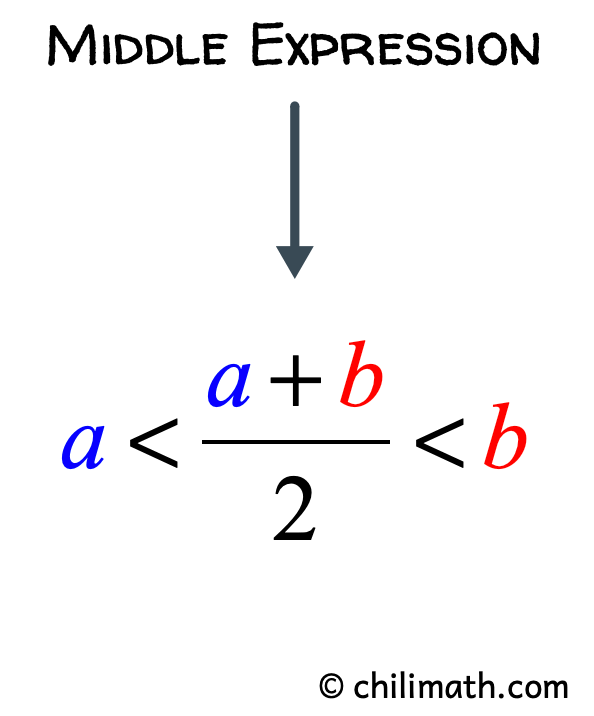
If we just focus on the middle expression of the compound inequality, the expression [latex]\Large{{a + b} \over 2}[/latex] is the average of the two real numbers [latex]\color{blue}a[/latex] and [latex]\color{red}b[/latex] but [latex]a \ne b[/latex].
Putting together what we know now, the theorem is claiming that the average of two distinct numbers [latex]\color{blue}a[/latex] and [latex]\color{red}b[/latex] is greater than [latex]\color{blue}a[/latex] (the smaller number) but less than [latex]\color{red}b[/latex] (the larger number).
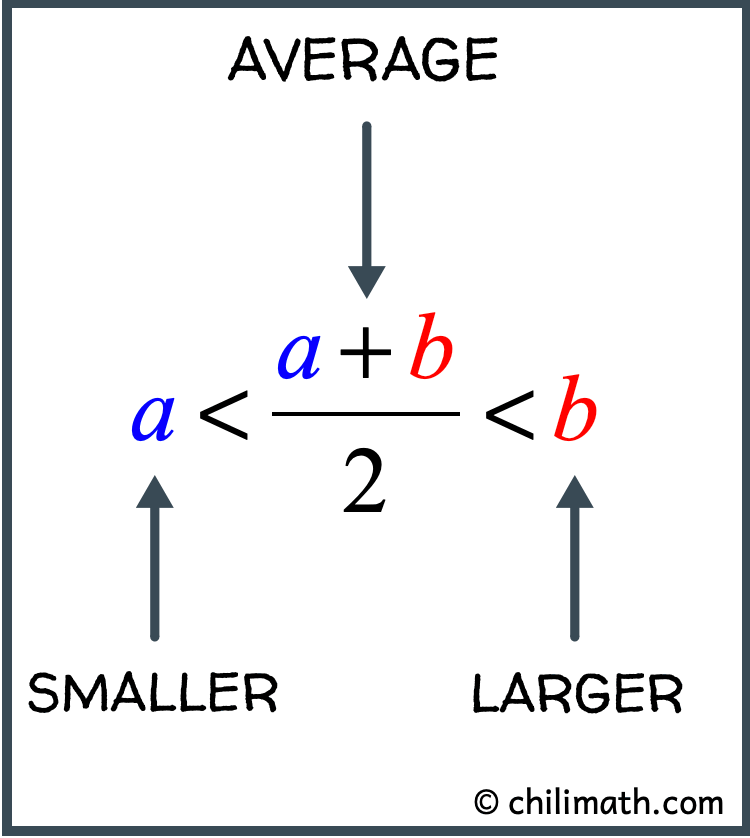
Since the conclusion is a compound inequality (conjunction), then we are going to prove two separate cases in order to prove the original theorem.
Case 1: If [latex]a<b[/latex], then [latex]a < {\Large{{{a + b} \over 2}}}[/latex].
Case 2: If [latex]a<b[/latex], then [latex]{\Large{{{a + b} \over 2}}} < b[/latex].
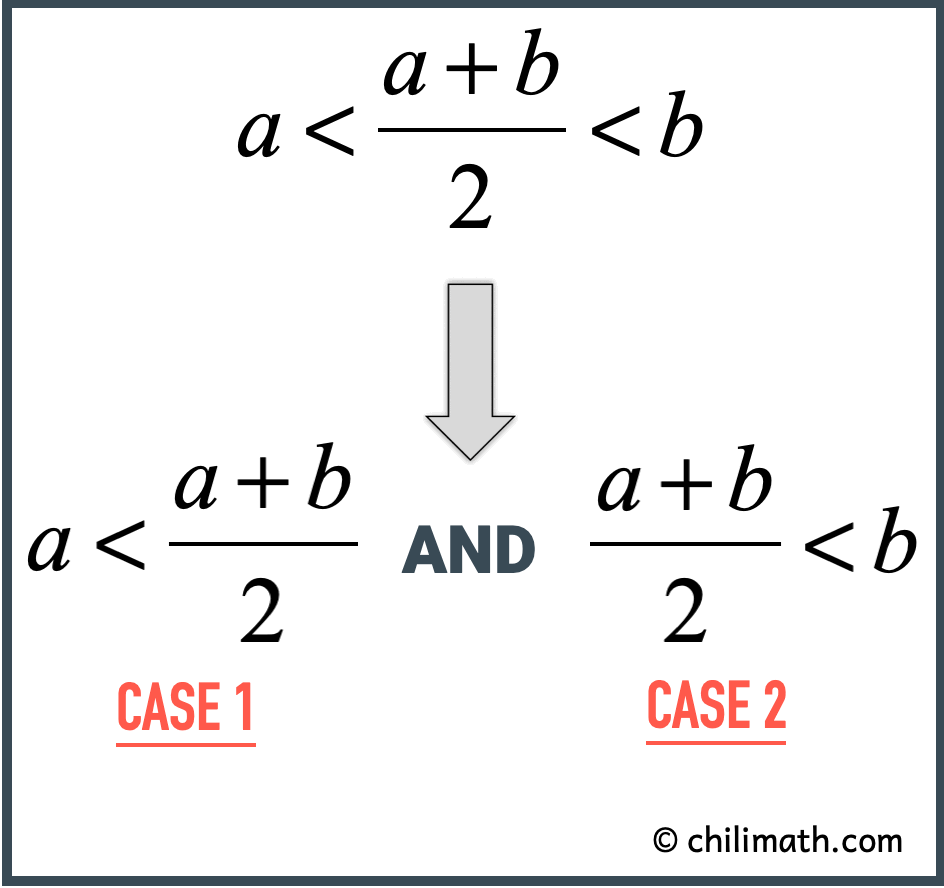
BRAINSTORM BEFORE WRITING THE PROOF
Note: The purpose of brainstorming in writing proof is for us to understand what the theorem is trying to convey; and gather enough information to connect the dots, which will be used to bridge the hypothesis and the conclusion.
The next step is to strategize how we are going to prove the theorem by proving the two cases using the Direct Proof Method.
But first, let’s test out the theorem with actual numbers and verify if indeed it is true.
Test 1: Say [latex]a=2[/latex] and [latex]b=6[/latex]. Note, it is true that [latex]a<b[/latex] since [latex]4<6[/latex].
Substitute the values of [latex]a[/latex] and [latex]b[/latex] then simplify.
[latex]a < {\Large{{{a + b} \over 2}}} < b[/latex]
[latex]4 < {\Large{{{4 + 6} \over 2}}} < 6[/latex]
[latex]4 < {\Large{{{10} \over 2}}} < 6[/latex]
[latex]4 < 5< 6[/latex] ✔︎
Test 2: Suppose [latex]a=-3[/latex] and [latex]b=3[/latex]. It is true since [latex]a<b\,\,[/latex] ⇨ [latex]\,-3<3[/latex].
Plug in the values of [latex]a[/latex] and [latex]b[/latex] into the compound inequality then simplify.
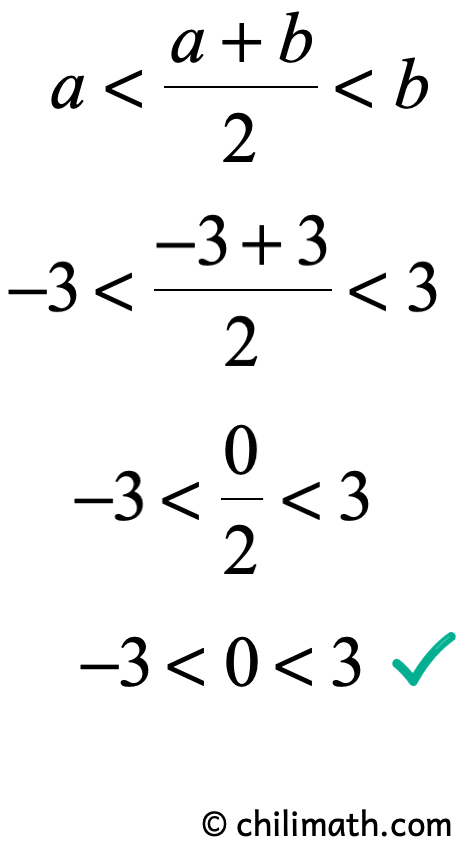
We will prove Case 1 and Case 2 to prove the theorem. Below is the “big picture” again.
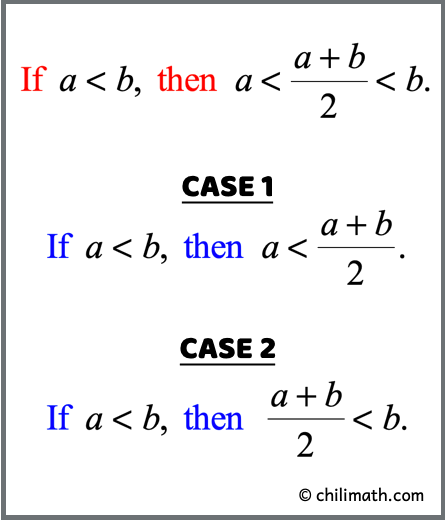
SCRATCHWORK FOR CASE 1
Case 1: If [latex]a<b[/latex], then [latex]a < {\Large{{{a + b} \over 2}}}[/latex].
For Case 1, the goal is to start with the hypothesis [latex]a<b[/latex] then perform some algebraic manipulations to get to the conclusion [latex]a < {\Large{{{a + b} \over 2}}}[/latex].
It may not be obvious at first to show [latex]a<b\,[/latex] [latex]\Large \to [/latex] [latex]\,a < {\Large{{{a + b} \over 2}}}[/latex]. However, if we can work it out backwards, such that we begin with [latex]\,a < {\Large{{{a + b} \over 2}}}[/latex] and work towards [latex]a<b[/latex], then we might have just found a way to get from [latex]a<b[/latex] to [latex]\,a < {\Large{{{a + b} \over 2}}}[/latex].
Side Calculation:
- Start with [latex]\,a < {\Large{{{a + b} \over 2}}}[/latex].
- Multiply both sides of the inequality by [latex]\color{red}2[/latex] to cancel out the denominator [latex]2[/latex] on the right side of the inequality.
- Subtract both sides of the inequality by [latex]\color{red}a[/latex].
- Voila! We got what we wanted!
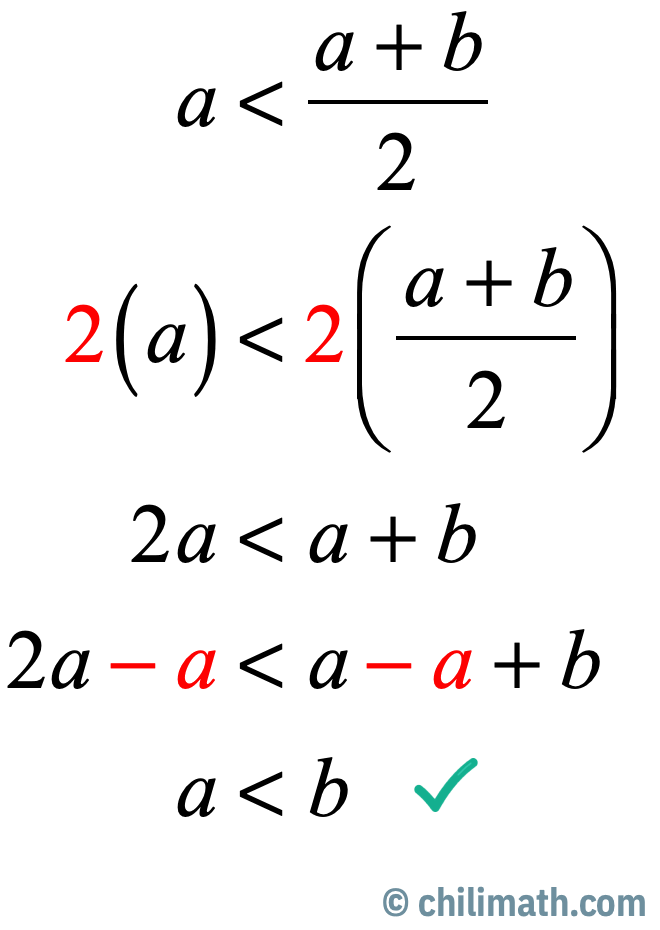
Great! Now, the only thing left that we have to do is to reverse the operations. This means we’re going to add [latex]\color{red}a[/latex] on both sides of the inequality followed by dividing both sides by [latex]\color{red}2[/latex].
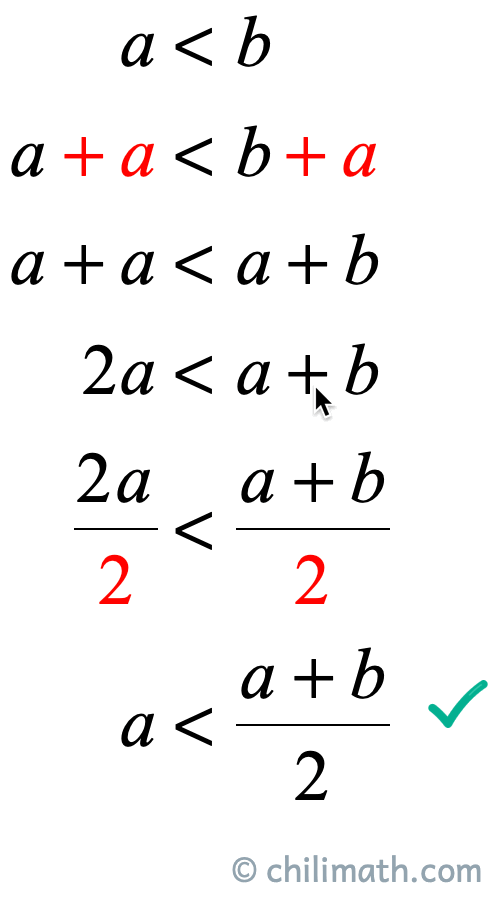
Case 1 is now proved! Let’s move on to the next case.
SCRATCHWORK FOR CASE 2
Case 2: If [latex]a<b[/latex], then [latex]{\Large{{{a + b} \over 2}}} < b[/latex].
For Case 2, we will apply what we have learned from the scratchwork of Case 1. So then, this time we are going to add [latex]\color{red}b[/latex] instead on both sides of the inequality then equally divide both sides by [latex]\color{red}2[/latex].
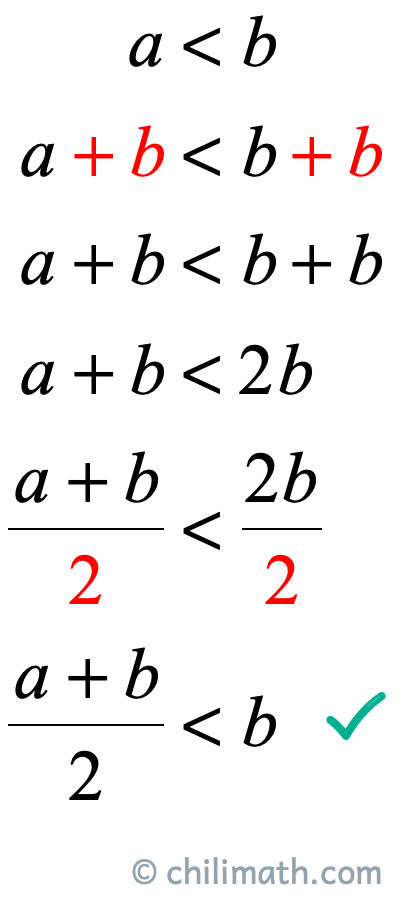
Case 2 is also proved! We should now be equipped with enough information to write the proof.
WRITE THE PROOF
THEOREM: Assume that [latex]a,b \in \mathbb{R}[/latex], if [latex]a < b[/latex] then [latex]a < {\Large{{{a + b} \over 2}}} < b[/latex].
PROOF: To prove the conditional statement if [latex]a < b[/latex] then [latex]a < {\Large{{{a + b} \over 2}}} < b[/latex], we need to break it down into two cases. The first case to prove: If [latex]a<b[/latex], then [latex]a < {\Large{{{a + b} \over 2}}}[/latex]. The second case to prove: If [latex]a<b[/latex], then [latex]{\Large{{{a + b} \over 2}}} < b[/latex]. Begin by proving Case 1. Given that [latex]a < b[/latex], we add [latex]a[/latex] on both sides of the inequality to get [latex]a + a < a + b[/latex] which can be simplified as [latex]2a < a + b[/latex]. Next, we divide both sides of the inequality by [latex]2[/latex] to get [latex]a < {\Large{{{a + b} \over 2}}}[/latex]. We have just proved the first case. For Case 2, given that [latex]a < b[/latex], we add [latex]b[/latex] on both sides to get [latex]a < b \to a + b < b + b[/latex] which is further simplified as [latex]a + b < 2b[/latex]. Now divide both sides by [latex]2[/latex] to get [latex]{\Large{{{a + b} \over 2}}} < b[/latex]. We have just proved the second case. Since, we have proved the two required cases, then we have proved the original theorem which is, if [latex]a < b[/latex] then [latex]a < {\Large{{{a + b} \over 2}}} < b[/latex].◼︎
